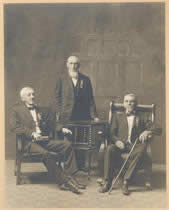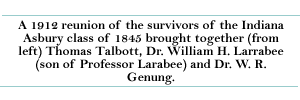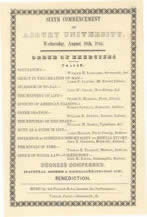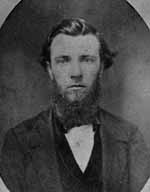|

Pages:
<< Back 1
2 3 4
5 6 7
8 9 10
Next >>
As
a professed Christian university, Indiana Asbury may be considered
a pioneer in the teaching of the natural sciences within and alongside
the traditional classical curriculum. In 1849, for example, the
university established a two-year scientific department which permitted
students aiming for careers in teaching or business to substitute
for Latin and Greek more "practical" subjects such as
science and modern languages. Extended to three years in 1854, this
new course became a four-year program leading to the degree of bachelor
of science in 1858.
 
The heart of the curriculum, however, remained the classical languages.
When Cyrus Nutt resigned in 1843, Benjamin
Tefft, a second Wesleyan graduate to join the Asbury faculty, served
as professor of Greek and Hebrew for three years. From 1846 to 1849
Nutt was back teaching Greek and after another off campus interlude
ended his Asbury career as professor of mathematics from 1857 to
1860, as well as vice president and acting president. His successors
as professors of Greek were Henry C. Benson (1850-1852) and Samuel
A. Lattimore (1852-60), both recent graduates. Another pioneer teacher
at Indiana Asbury, John Wheeler, was professor of Latin language
and literature from 1842 to 1854.


_________________________________________
Dr. William R. Genung, a physician
and member of the
Indiana General Assembly, graduated in 1845. He
also delivered the Greek oration.
_______________________________________________
In
his "Reminiscences of Thirty Years in Asbury" published
in the Asbury Review in 1873, Professor Joseph
Tingley gave a vivid wordpicture of the campus and town about
the time of his arrival as a student 30 years before:
Conspicuous amid the low, white houses, which dotted here and
there the fields around, towered the college building. Its newly
painted white belfry, with bright green blinds, its ground is bare
o f trees and exposing patches of the yellow clay which had been
loosened by recent grading, testified that the institution was yet
in its young life .... The remaining portion of the village presented
a rude and uninviting appearance. Its nine hundred inhabitants seemed
to have expended their whole stock of enterprises and public spirit
upon the one object of founding the University, and to have nothing
left for further improvement....
The business centre of Greencastle, then as now, was the public
square. It consisted of a group of unsightly houses, mostly built
of wood, surrounding a rickety court house in the form of a cube
attached to a very tall sharp pointed spire bearing two guilt balls
and a weather vane. The maufacturing interests were represented
by various establishments devoted to chair-making, shoe-making and
carpentering, each employing one hand including the proprietor.
There was also a wool-carding mill turned by horse power, which
you passed between the college and the square, and across the ravine
over which it was built, stretched a solitary log, flattened upon
its upper side for the convenience of footmen. This rustic bridge
formed a part of the principal path, (there were no pavements) connecting
those two great centres of commerce and literature....
Almost adjoining the college out-lot on the east, was a partially
cleared space, [East College yard]
overgrown with briars, and south of this a grove containing a dense
undergrowth of paw paw bushes....
Hitherward the hilarious students, wearied quite too soon with
study, resorted for fun and frolic; and having "met and battled
with the foe," returned with subdued spirit, scarred and battered
clothes, and other evidences of the fact that (if not a veteran)
he was, at least, (black) eye witness to the memorable scenes of
the Paw Paw war....Yet a little further westward [Blackstock Field]
were the hunting grounds of the snipe hunter, where in midnight
darkness, the uninitiated applicant, having been instructed to "put
out the light," was left alone to "hold the bag"
while the initiated, under cover of a promise to surround and drive
the snipes therein, first slyly and then precipitately retreated
to their boarding houses.
Back
to Top
Pages:
<< Back 1
2 3 4
5 6 7
8 9 10
Next >>
|





